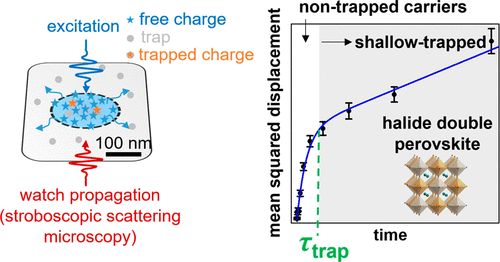当前位置:
X-MOL 学术
›
ACS Energy Lett.
›
论文详情
Our official English website, www.x-mol.net, welcomes your
feedback! (Note: you will need to create a separate account there.)
Carrier Diffusion Lengths Exceeding 1 μm Despite Trap-Limited Transport in Halide Double Perovskites
ACS Energy Letters ( IF 19.3 ) Pub Date : 2020-04-02 , DOI: 10.1021/acsenergylett.0c00414 Milan Delor 1 , Adam H. Slavney 2 , Nathan R. Wolf 2 , Marina R. Filip 3, 4 , Jeffrey B. Neaton 3, 4, 5, 6 , Hemamala I. Karunadasa 2 , Naomi S. Ginsberg 1, 3, 5, 6, 7
ACS Energy Letters ( IF 19.3 ) Pub Date : 2020-04-02 , DOI: 10.1021/acsenergylett.0c00414 Milan Delor 1 , Adam H. Slavney 2 , Nathan R. Wolf 2 , Marina R. Filip 3, 4 , Jeffrey B. Neaton 3, 4, 5, 6 , Hemamala I. Karunadasa 2 , Naomi S. Ginsberg 1, 3, 5, 6, 7
Affiliation

|
We image charge carrier transport over nanometers–micrometers and picoseconds–microseconds in halide double perovskites Cs2AgBiBr6 and Cs2AgTlBr6 single crystals using stroboscopic scattering microscopy. Both materials exhibit long, microsecond carrier lifetimes because of their indirect or symmetry-forbidden direct bandgaps. We extract free-charge and trap-limited mobilities near the surface and in the crystal bulk. The free-charge mobilities for both materials (∼10–50 cm2/(V s)) can reach those reported for archetypal lead halide perovskites. We measure trap densities exceeding 1017 cm–3 within ∼20 nm of the crystal surface. Measurements on freshly cleaved or thermally annealed crystals suggest the traps are primarily halide vacancies that likely form through surface bromine degassing. Although these traps considerably slow charge transport, they are energetically shallow, enabling thermally induced detrapping and mobile carriers over microseconds at room temperature. This defect tolerance yields carrier diffusion lengths exceeding 1 μm even in the presence of large trap densities and under solar excitation conditions where traps are not saturated. These results suggest that halide double perovskites could rival the best lead-based perovskites for photovoltaic and optoelectronic applications.
中文翻译:

尽管卤化物双钙钛矿中存在陷阱限制的运输,但载流子扩散长度仍超过1μm。
我们使用频闪散射显微镜,对卤化物双钙钛矿Cs 2 AgBiBr 6和Cs 2 AgTlBr 6单晶中的载流子在纳米级–微米级和皮秒级–微秒级的传输进行成像。由于它们的间接或对称禁止的直接带隙,这两种材料都具有较长的微秒载流子寿命。我们在表面附近和晶体主体中提取自由电荷和陷阱受限的迁移率。两种材料的自由电荷迁移率(〜10–50 cm 2 /(V s))可以达到原型卤化钙钛矿中的铅迁移率。我们测量的陷阱密度超过10 17 cm –3在晶体表面约20 nm以内。对新鲜切割或热退火晶体的测量表明,陷阱主要是卤化物空位,可能是通过表面溴脱气而形成的。尽管这些陷阱会大大减慢电荷的传输速度,但它们的能量却很浅,在室温下能够在几微秒内完成热感应去陷阱和移动载流子。即使在存在大的陷阱密度并且在陷阱不饱和的太阳激发条件下,这种缺陷容忍度也会产生超过1μm的载流子扩散长度。这些结果表明,卤化物双钙钛矿可以与光伏和光电应用中最好的铅基钙钛矿相媲美。
更新日期:2020-04-02
中文翻译:

尽管卤化物双钙钛矿中存在陷阱限制的运输,但载流子扩散长度仍超过1μm。
我们使用频闪散射显微镜,对卤化物双钙钛矿Cs 2 AgBiBr 6和Cs 2 AgTlBr 6单晶中的载流子在纳米级–微米级和皮秒级–微秒级的传输进行成像。由于它们的间接或对称禁止的直接带隙,这两种材料都具有较长的微秒载流子寿命。我们在表面附近和晶体主体中提取自由电荷和陷阱受限的迁移率。两种材料的自由电荷迁移率(〜10–50 cm 2 /(V s))可以达到原型卤化钙钛矿中的铅迁移率。我们测量的陷阱密度超过10 17 cm –3在晶体表面约20 nm以内。对新鲜切割或热退火晶体的测量表明,陷阱主要是卤化物空位,可能是通过表面溴脱气而形成的。尽管这些陷阱会大大减慢电荷的传输速度,但它们的能量却很浅,在室温下能够在几微秒内完成热感应去陷阱和移动载流子。即使在存在大的陷阱密度并且在陷阱不饱和的太阳激发条件下,这种缺陷容忍度也会产生超过1μm的载流子扩散长度。这些结果表明,卤化物双钙钛矿可以与光伏和光电应用中最好的铅基钙钛矿相媲美。































 京公网安备 11010802027423号
京公网安备 11010802027423号